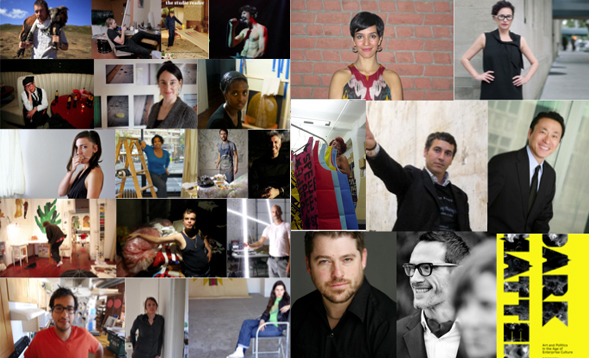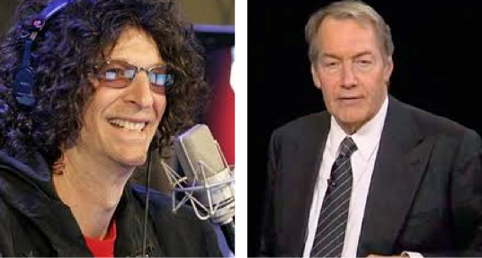
Inside the Artist's Studio Workshop. From left to right: Georgia Kotretsos; artist/curator/radio host Artemis Potamianou; and artist/curator/Deree's Visual Arts Department Head Effie Halivopoulou.
The School of Fine and Performing Arts at DEREE – The American College of Greece is celebrating the completion of its first academic year with a month of artistic and educational events that are open to the public. The Arts Festival started May 7, 2012 and will continue through June 7.
Attendees thus far have had the opportunity to visit exhibitions and attend concerts, performances, workshops, discussions, and master classes offered by DEREE faculty members and acclaimed artists and professionals. All four SFPA programs – Music and Music Performance, Theater Arts, Visual Arts, and Dance – are participating in the festival.
In today’s post, I would like to report on the Visual Arts Department of the School of Fine and Performing Arts of DEREE – ACG programming. The Festival began by welcoming New York based artist Sheila Pepe. The artist worked on a community-based installation in the Arts Center Gallery, from May 8-15. Over the duration of the installation, Pepe’s audiences and participants were invited to take part in an interactive “creational” experience. Interwoven with Pepe’s installations were a series of lectures and presentations.
On May 9th, along with artist and Visual Arts Department head Effie Halivopoulou, I took part in the Festival by presenting my “Inside the Artist’s Studio” column, where I discussed its initiation process, influences, structure, and the idea of visual artists developing habits of inquiry that could potentially inform their practice. I will elaborate on my presentation further on, but before doing so I should note that my presentation was followed by Artemis Potamianou‘s on “Art Therapy,” the radio show she hosts with psychologist George Oraiopoulos at Beton 7 in Athens every second Thursday of the month at 9 pm. Potamianou is a visual artist, curator and most recently a radio host who continues to astonish me with her multi-tasking abilities.
Potamianou also discussed the structure of her show and the importance of having creative voices appear on-air.
For two hours, the audience watched a presentation on the art of forming questions, which led to an anxious and, at times, agonizing discussion about the younger generation in Greece and its future in art. An engaging young crowd kept us on our toes for another hour. We could not have asked for a better audience.
Continuing on to other parts of the Festival, on May 10th, a presentation on the making of the 15th Biennale of Young Artists of the Mediterranean took place. Curators Effie Halivopoulou and Stephanie Bertrand discussed practices and strategies involved in installing the works of 142 artists from 26 countries of the Mediterranean and Europe. The idea of “symbiosis” served as the Biennale’s primary structure.
On May 17th, New Genres artist and DEREE Adjunct Professor Jennifer Nelson (an Andy Warhol grant recipient) presented her project “Securing a Free State, The 2nd Amendment,” done in residence at the Arizona State University Museum. The project investigated individual and collective choreographies to find or regain a sense of security. Nelson’s presentation was followed by three-one hour workshops. Having taken part in two of these workshops thus far, I can say that Nelson is opening up a discussion that is, beyond everything else, necessary, and she does it in an engaging, constructive and therapeutic manner. The notion of security is being re-evaluated and re-considered in Greece at this moment as well as during these workshops, and I’m hoping to see more initiatives by artists who are willing to facilitate alternative dialogues.
All events were free and open to the general public; nonetheless, registration for workshops, master classes and theatre performances was required. Keep that in mind for those of you who plan to attend next year’s Festival.
Next, I’d like to talk about the educational rewards for visual artists who are interested in developing their critical thinking skills as interviewers. When it comes to the interview, as with art, the best questions are those that can be located somewhere in your body. In other words, where it already exists. But, where is it coming from? Trained to be(lie)ve we’re only thinking with our minds is a handicap. In this case, in regards to my own influences, two entirely different models of interviewer come to mind: Howard Stern and Charlie Rose.
American radio show host Howard Stern, always confrontational, controversial, sexist, intimidating, and vulgar, is considered a form of “low” pop culture. He is seemingly talking out of his ass, but it’s literally out of his smart-ass, and that is lesson number one. One the other hand, classic, “high culture” interviewer Charlie Rose is considered to be a trustworthy host who’s a master at forming informed questions that reveal his own intellectual substance. The approaches taken by both interviewers are of great educational value and power. To me, both offer examples of how to find your voice as an interviewer. Keep in mind there are myriad parts of your body between your ass and mind.
But before you venture further into the practice of interviewing others, consider these questions first, especially if you are an artist:
Do all of us possess inquiring minds?
Why should we (artists) make it our business to ask questions?
How can we train ourselves?
Are there educational benefits in being trained to be skilled art conversationalists?
Are there educational benefits in knowing how to approach other art professionals and especially our peers?
Are there educational benefits in breaking away from our own ego-bubbles by looking outwards?
How can we find our voices?
I will not answer these questions directly, but I’ll put them out there for you to think about just as I did with my presentation at the Deree Arts Festival. Interviewing others is a time-consuming process, but most importantly it is an investment in art whether your interviews are published in magazines, blogs or aired on television or radio. Seeking and creating the conditions for dialogue has been the most rewarding art endeavor for me and it has informed my studio practice immensely. Finding new opportunities has also been a highly creative process. Evaluate the quality of your daily art conversations and create the conditions where their quality cannot be compromised: that idea has been my driving goal for this column, a remedy I prescribed to myself in order to attain a healthier art practice. Once a month, someone else lets me into their creative universe. It’s my day off.
Above all, as visual artists we are not trained to find joy in the work of our peers; this is another handicap we have to overcome.
So, here are some of the featured interviewees who’ve let me into their universe over the past two years:

Emerging artists: Juozas Cernius, Jan-Henri Booyens, The Studio Reader, Paul Zografakis, Christa Holka, Rachel Moore, Loul Samater, Jason Bailer Losh, Joulia Strauss, Lisa Bradley, Alexis Avlamis, Bernard Viljoen, Pesce Khete, Flo McGarrrell, Jason Peters, Corey Escoto, Seoidin O’Sullivan & Dafni E. Barbageorgopoulou. Mid-career and established professionals: Leeza Ahmady, Sofia Hernandez Chong Cuy, Abdellah Karroum, Paul C. Ha, Nato Thompson, Jenny Marketou, Storm Janse van Rensburg, and Gregory Sholette.
The Festival’s presentations came together when Artemis Potamianou talked about the freedoms and challenges of hosting a radio show at Beton 7. During his talk, Potamianou shared many insightful observations about the habitual patterns and anxieties of artists who are being interviewed on the air. Differences between the written and spoken word were discussed, and the need to have platforms and artists who reach out to the creative community. Potamianou and Oraiopoulos identified the need for communication in the midst of an escalating crisis. They are capturing the pulse of the change this community is undergoing.
The workshop conducted on a Q and A basis that followed was filled with a sense of uncertainty, anxiety and hope. I am currently working with some of the students who were present and I am convinced they possess all the qualities necessary to be part of this change.
Nonetheless, conversations do have to evolve, and I’m just about ready to focus on what’s happening exclusively on this side of the world. This crisis is a one-of-a-kind opportunity to re-define contemporary art practice in Greece, which will not be as easy as simply christening symptoms with bombastic art blabber, as we’ve seen in the past. The best way to go about it is by asking all the right questions.
And, that’s a wrap!






